Last Updated on August 31, 2025 by Owen McGab Enaohwo

“That’s the fourth client we’ve lost in the last two weeks, sir,” said the product manager, with a worried look on his face. He handed over the report to the CEO of a software company only in its second year of operation.
The CEO scanned the report and sighed. He knew that his company was facing a serious problem. The event ticketing software his team developed had many defects, an interface that could compete for the world’s ugliest-looking design, and the customers were not satisfied with the quality, speed, and performance of its operations.
The competitors were offering better and more user-friendly solutions, and the market share was shrinking.
He decided to take action and implement a quality improvement program in his company. With the help of its support team, he identified the root causes of the software defects and came up with some improvement ideas. They tested the ideas on a small scale and collected data and feedback. They analyzed the results and made changes as needed. They scaled up the successful ideas and standardized the new processes.
The QI approach had a positive impact on the quality and efficiency of his software. It became more reliable and user-friendly, and the customers were happier. The company regained its reputation and its business. It was then that good ol’ Sam realized that QI was not only a way to solve problems but also a way to create value and innovation.
Quality improvement (QI) is a systematic approach that aims to improve the efficiency, effectiveness, and adaptability of organizational processes or systems. It’s a roadmap for continuous improvement that guides businesses toward their goals.
The benefits of QI are numerous, ranging from improved customer satisfaction to increased revenue growth. But where do you start, and how do you get there? This article will explore the principles, tools, and benefits of QI and provide actionable steps to implement it in your business.
To help you on your journey, we recommend SweetProcess. Our software provides a wide range of tools and products to help you identify the areas of your business that need improvement, create an improvement plan, and implement it. Sign up for our free trial today, and take the first step toward creating a better business.
What You’ll Learn In This Post:
Importance of Quality Improvement in a Business
How to Nurture a Culture of Quality Improvement in Your Company
Improving the Quality of Your Products and Services Using SweetProcess
Fundamental Principles of Quality Improvement
Benefits of Quality Improvement in Different Industries
Quality Improvement Methodologies
Differences Between Quality Improvement and Quality Assurance
Build Your Company’s Quality Improvement Process with SweetProcess
What Is Quality Improvement?

Quality improvement (QI) is a systematic approach that seeks to improve the efficiency, effectiveness, and adaptability of organizational processes or systems. It aims to enhance a product’s value, functionality, and performance.
Imagine you’re baking a cake. You follow a recipe, but the result isn’t quite what you expected. So you tweak the recipe, maybe add a bit more sugar, or bake it for a little longer. You continue this process until you get the perfect cake.
You can also consider it as fine-tuning a musical instrument. You start with a basic tune, but it’s not perfect. So you adjust the strings, test the sound, and continue this process until you achieve the perfect melody.
That’s essentially what QI is: It’s about making changes, assessing the results, and then making more changes to achieve the “perfect cake,” “perfect melody,” or, in business terms, optimal performance.
The purpose of QI in product development is to increase customer satisfaction and market share by continually improving the product. It’s like a compass, continually pointing your business toward its goals, ensuring you stay on the right path.
By implementing QI, organizations can ensure they’re not just doing things right, but they’re doing the right things.
Importance of Quality Improvement in a Business

Competitive Edge
To stand out in today’s highly competitive markets, a business needs a product of superior quality. QI ensures that a product satisfies or surpasses what customers want, giving the business an edge over its rivals.
Customer Satisfaction
A product of high quality increases customer satisfaction. When a product delivers on its expectations reliably, it fosters customer trust and fidelity.
Operational Efficiency
Quality improvement entails making processes more efficient to avoid unnecessary expenses and reduce costs. By applying lean process improvement strategies, businesses can streamline workflows, eliminate waste, and optimize resources. This approach enhances operational performance, allowing the business to produce products faster, reduce errors, and lower costs—all while maintaining high-quality standards.
Regulatory Compliance
QI helps businesses comply with industry standards and regulations. Regulatory compliance reduces the risk of penalties and enhances the business’s reputation.
Revenue Growth
An immediate benefit of customer satisfaction and operational efficiency is increased revenue. When a product conveniently satisfies the needs of its customers, they’re more likely to make recurring purchases and recommend the product to others through word of mouth.
Improved Productivity
QI helps increase productivity by identifying and eliminating inefficiencies. Consequently, employees can concentrate on the work that matters, resulting in higher output and improved quality.
How to Nurture a Culture of Quality Improvement in Your Company

Cultivating a culture of quality improvement (QI) in your company is a strategic move that can lead to significant benefits. Here are some ways to nurture this culture.
Provide Training and Education on Quality Improvement
Equip your employees with the knowledge and skills they need to contribute to QI. This could involve workshops, seminars, or online QI methodologies and tools courses.
Engage All Employees in Improvement Processes
QI isn’t just the responsibility of managers or a specific department. It should involve everyone in the workplace to help identify areas for improvement and implement the necessary changes.
Establish Clear Processes
Clear, well-documented processes make it easier to identify where to make improvements. They also ensure consistency and reduce the likelihood of inefficiencies or errors.
Create Open Communication Channels
Encourage employees to share their ideas and feedback. Open communication fosters a collaborative environment where continuous improvement is the norm.
Encourage Learning From Mistakes
Instead of penalizing errors, use them as learning opportunities. This method encourages employees to take calculated risks and fosters innovation.
Share Success Stories
Highlighting successful quality improvement initiatives can motivate employees and show them the tangible benefits of their efforts.
Invest in Necessary Technology
The right technology can streamline processes, improve accuracy, and provide valuable data for decision-making. Our software, SweetProcess, comes highly recommended.
Celebrate Achievements
Recognize and reward employees for their contributions to improving the company’s products or services. This not only boosts morale but also reinforces the significance of continuous quality improvement.
Implement Monitoring and Updating Systems
Regularly review and update your processes to ensure they remain effective and efficient. This underscores the ongoing nature of QI.
Improving the Quality of Your Products and Services Using SweetProcess

In the quality improvement (QI) journey, having the right tools can make all the difference.
One of the said tools is SweetProcess, our robust platform designed to streamline your quality improvement process. From creating detailed standard operating procedures (SOPs) to documenting processes and procedures, SweetProcess offers a suite of features to enhance your QI journey.
This section will guide you on leveraging SweetProcess to improve the quality of your products and services. Let’s dive in!
Why Is the Implementation of SOPs Important?
The implementation of standard operating procedures (SOPs) is crucial for several reasons. First and foremost, SOPs ensure consistency and reliability in delivering products and services in an organization. They guarantee the same standard of product quality across different production terminals and plants.
In addition to ensuring maximum quality, SOPs also improve efficiency. SOPs such as policies, procedures, and processes function as checklists and can help workers save time during routine operations. They provide a structured and sequential guide to carry out routine and/or hazardous operations, enhancing efficiency.
From a business perspective, improved efficiency and consistent product quality can boost profit margins. This is achieved by increasing productivity and reducing the incidence of product recalls and reworks.
SOPs also play a vital role in onboarding and training. They can supplement training, making it easy for new workers to perform tasks with which they may not be adequately familiar.
Furthermore, SOPs can document tacit knowledge that may have only existed in the minds of long-lasting or founding workers, ensuring continuity in production.
Finally, SOPs serve a regulatory purpose. Audit inspectors often cite SOPs to gauge a manufacturer’s quality culture.
How to Document Processes and Procedures Using SweetProcess
Here are the steps to document a new procedure using SweetProcess:
- Sign in to SweetProcess.
- Click on the “Create Procedure” button.

3. Type in your procedure title.

4. Choose one or more teams to assign the procedure to.
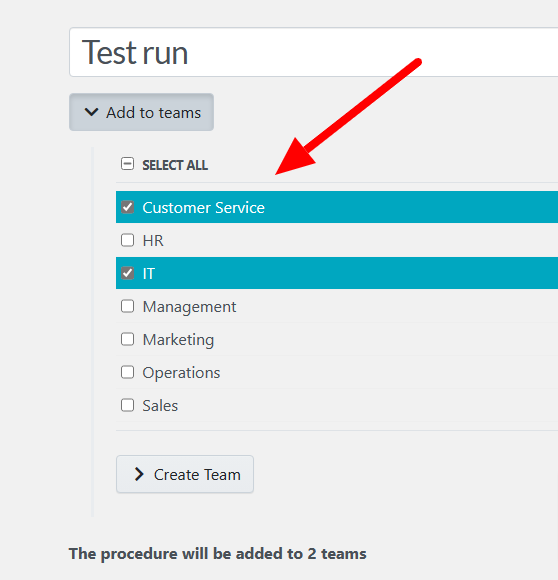
5. Click on the “Continue” button.

6. Add a description by clicking on the procedure title.
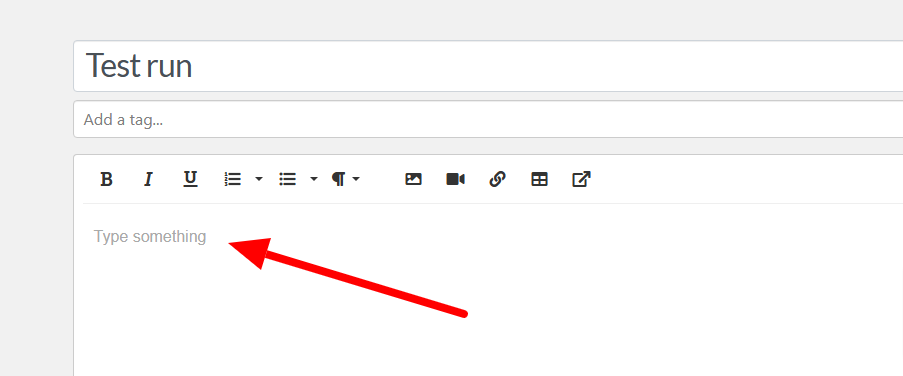
7. Add some tags to help identify the procedure later.
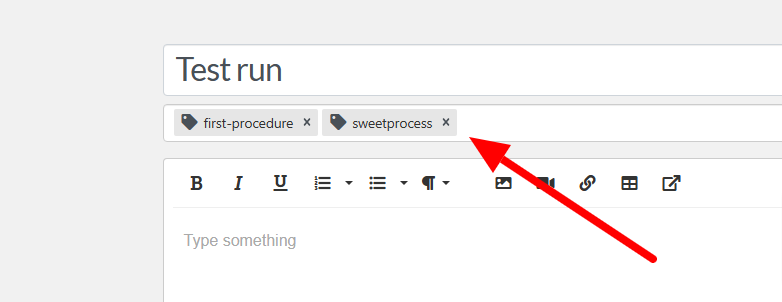
8. Select “Add a Step.”

9. Name your step and give it a description.
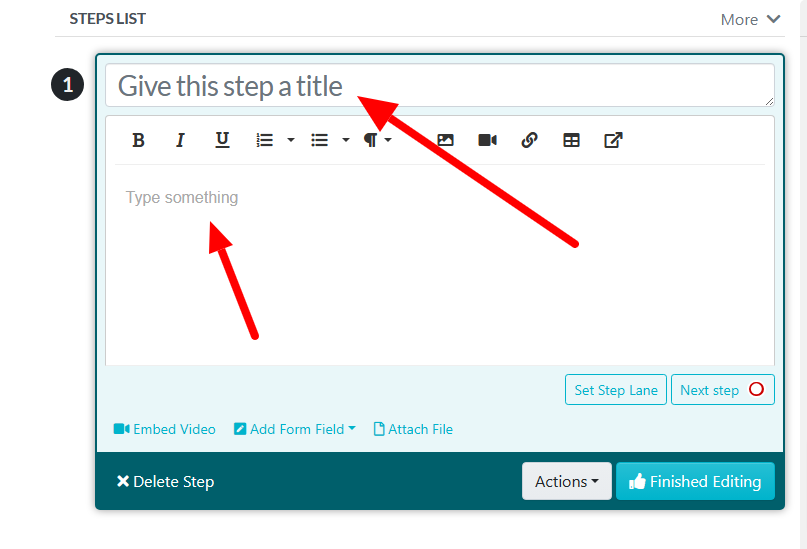
10. Drag and drop images from your computer to the step.

11. Select “Finished Editing” to save the step draft.

- To add another step, click on “Add a Step” and repeat steps 7 to 10.
- Repeat step 11 until you have all the steps you need.
12. To publish the procedure, select “Approve” or “Request Approval” if you don’t have permission.

- To go back to the dashboard to manage all your procedures, tap on the “Procedures” link above.

A Case Study
Being able to create procedures has made a huge difference for many of our clients and businesses around the globe. One company that’s done well with it is Rise25.
Rise25, a podcasting company co-founded by Dr. Jeremy Weisz and John Corcoran, faced challenges with their unstructured standard operating procedures (SOPs) in Google Docs.
The team found it difficult to work effectively with the procedure documentation system they were using, and Jeremy constantly needed to locate and follow the SOPs. To enhance its operations, Rise25 turned to SweetProcess.
Despite initial concerns about the cost, the onboarding training and the system proved to be straightforward to use, providing a stark contrast to their experience with Google Docs.
The implementation of SweetProcess significantly increased customer satisfaction levels and streamlined operations, allowing team members to deploy SOPs themselves and freeing Jeremy from being in a bottleneck.
Here are the steps to create a new process using SweetProcess:
- To access the “Processes” tab, click on the “More” dropdown menu at the top of the screen and click on “Processes.”
- When the page loads, click on the “Create Process” button at the top right of the page or the “Create a Process” button at the center of the screen.

3. Give the process a name.

4. Select one or more teams to add the process to by checking the boxes next to them.

5. Tap the “Continue” button.

6. Click on the process title and add your description in the appropriate textbox.
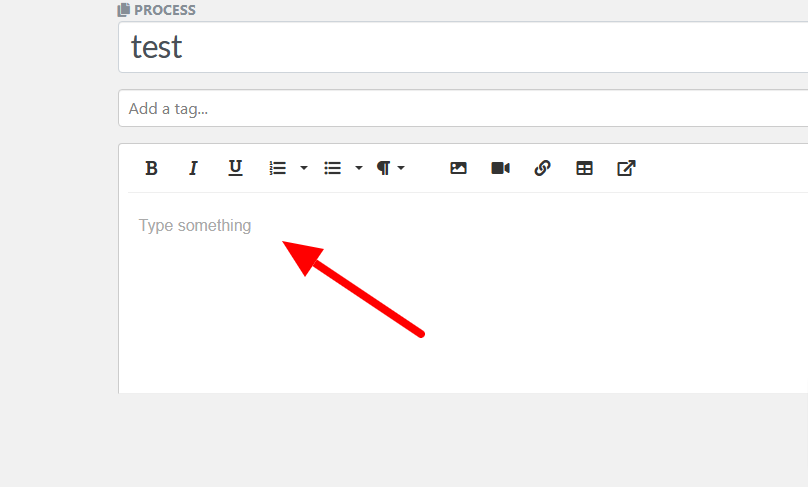
Case Studies
When it comes to being able to document processes, businesses have greatly benefited from this awesome feature provided by SweetProcess. You, too, can take advantage of it and experience the positive impact it can have on your business, just like Benchmark Wealth Management.
Benchmark Wealth Management, a financial advising firm, experienced rapid growth due to its team-based approach to financial planning.
However, the lack of universally accepted standard operating procedures (SOPs) led to inconsistencies in task execution. This inconsistency posed a significant challenge to the firm’s growth despite the competency of its staff.
While the team had a notebook where they documented most of their processes, the information quickly became outdated.
To overcome this challenge, the team set out to find a software application for process documentation.
They discovered SweetProcess, a process management software that helped the organization streamline its operations and enhanced its team members’ efficiency.
With SweetProcess, the team could finally document current processes effectively. The system offered several documentation features, allowing them to use various elements such as images, videos, and charts for documentation purposes.
As a result, there was a significant improvement in operational consistency and efficiency. The team could now perform tasks standardized and efficiently, leading to fewer errors and a better experience for clients.
Then there’s also MiPA, a UK-based company founded by Emma Mills. It helps business owners and entrepreneurs focus on growing their businesses by taking care of repetitive tasks and handling back-and-forth communications between business owners and their customers.
Despite having a competent team, Emma realized that they needed a more effective workflow management tool to keep up with the growing needs of the business. They tried using Dropbox to document their processes, but it quickly became apparent that this solution needed to be revised for their needs.
In search of a better tool, they discovered SweetProcess. This platform has significantly improved their operations, allowing them to offer customized services to their customers. With SweetProcess, they have scaled up their service in a bespoke way, serving people in the particular way they want.
The implementation of SweetProcess has been a game-changer for MiPA. It has enabled them to document their processes effectively and offer personalized services to each customer, resulting in increased efficiency in handling the communication needs of many businesses.
If you’re happy with the testimonies from our clients above, you should try out SweetProcess.
Our software provides a comprehensive suite of tools and products to help you document your processes, streamline your operations, and enhance your team’s efficiency.
With SweetProcess, you can identify areas for improvement, create an improvement plan, and implement it effectively, paving the way for a better business.
Sign up for our 14-day free trial today and start your journey toward quality improvement.
How to Use the Historical Version in SweetProcess to Track and Control Process Changes
Here are the steps to view the version history of a process in SweetProcess:
- To see a process’s version history, tap the clock icon while viewing it.
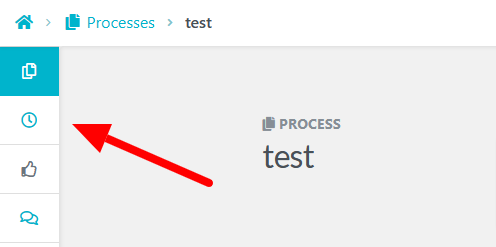
2. This will show the version history sidebar menu with the current and previous versions of the process.
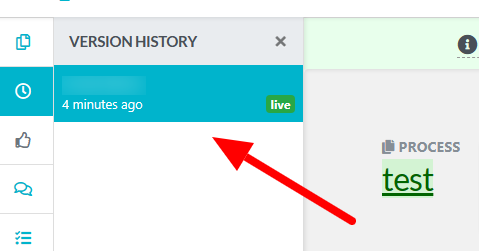
3. To view a specific version of the process, click on it once the sidebar menu opens up.
How to Leverage Flowcharts to Identify Opportunities for Improvement
Flowcharts are powerful tools for identifying opportunities for improvement in any process. They provide a visual representation of a process, depicting the sequence of steps, decisions, and interactions within it.
Here’s how you can leverage flowcharts for quality improvement:
- Understand the Process
Begin by creating a flowchart of the current process. This will allow you to better understand the process and pinpoint any areas that might need improvement.
- Identify Bottlenecks
You can use flowcharts to identify areas in your process where work accumulates due to its fast arrival, causing inefficiency.
- Spot Redundancies
Flowcharts are an effective tool for identifying redundancies or repetitive steps in your process. Eliminating these redundancies can significantly increase the efficiency of your process.
- Analyze Dependencies
When utilizing flowcharts, it is possible to understand the relationships between different steps in a process.
With this information, you can identify areas where changes to the sequence of steps could lead to improvements. This is an effective way to optimize your processes and increase overall efficiency.
- Communicate the Process
Flowcharts are a fantastic way to communicate a process. Utilizing them can help you share the process with others and gather their insights for improvement.
- Design Improved Process
Flowcharts can be a valuable tool for designing an improved process. By utilizing them, you can easily compare the “before” and “after” flowcharts to assess the improvements made. This can help you to communicate the process effectively with others and gather valuable insights from them.
Fundamental Principles of Quality Improvement

1) Customer Focus
Customer focus is a central principle of quality improvement (QI). QI aims to meet or exceed customer expectations by providing high-quality products or services that satisfy their needs. This principle emphasizes the significance of understanding customer needs and preferences to improve product or service quality continuously. One effective way to align with this principle is to use software to create an onboarding workflow that personalizes the customer journey from the very beginning.
2) Employee Involvement
The involvement of employees in the working environment is essential to quality improvement. Every employee, regardless of their role, can contribute valuable insights and innovative solutions to improve processes, products, and services. This principle encourages organizations to create a culture where employees feel empowered to participate in improvement efforts.
3) Data-Driven Decision-Making
Data-driven decision-making is a critical principle in quality improvement (QI). It emphasizes the importance of using data, rather than assumptions, to guide improvement efforts and make informed decisions.
Collecting, analyzing, and using data is essential to understanding the current operations state and identifying improvement areas.
4) Process Orientation
Process orientation is a crucial principle that recognizes that outcomes result from processes and emphasizes the importance of improving processes to enhance product or service quality.
A continuous quality improvement approach ensures that these processes are consistently evaluated and refined to drive long-term success.
5) Continuous Improvement
Continuous improvement emphasizes the importance of continuously seeking ways to improve processes and outcomes, fostering a perpetual learning and improvement culture.
6) Standardization
Standardization is a vital aspect of quality improvement (QI) that aims to promote consistency and reduce variability in processes and outcomes.
Through the development and implementation of uniform standards, businesses can ensure that their products and services meet the same high level of quality every time, which ultimately leads to increased customer satisfaction and loyalty.
In other words, standardization can help businesses achieve their QI goals by ensuring everyone is on the same page and working toward the same objectives.
7) Prevention Over Inspection
This principle emphasizes the importance of taking proactive measures to prevent defects or errors in products or services.
Rather than relying solely on inspections and error corrections after the fact, it’s about building quality into processes from the beginning to avoid issues altogether. A well-structured business continuity plan follows the same approach—focusing on preemptive strategies to ensure operations remain uninterrupted rather than scrambling for solutions after a disruption occurs.
Top Quality Improvement Tools

Quality improvement (QI) involves various tools that help in analyzing processes, identifying problems, and implementing solutions. Each tool has unique strengths and can be used in different scenarios. The key is to choose the right tool for the right situation to drive effective quality improvement. Here are some of the top QI tools:
Pareto Analysis
Pareto analysis is a tool based on the Pareto Principle, also known as the 80/20 rule.
This principle states that 80% of problems are typically caused by 20% of the causes. Pareto analysis helps identify the most significant factors in a set of data by prioritizing the 20% of factors that contribute to 80% of the problems.
This analysis can help organizations focus on the most critical issues and achieve more efficient problem-solving.
Flowcharts
A flowchart is a visual representation of a process that shows the steps involved in completing a task.
It provides a clear picture of the process, making it easier to understand how it works and identify areas for improvement.
Flowcharts are commonly used in business to map workflows, decision-making processes, and other complex procedures.
Scatter Diagram
A scatter plot is a graphical tool that displays the relationship between two variables.
It helps identify patterns, trends, and possible connections between different factors.
This graphical tool is used in data analysis to visualize the relationship between two sets of data.
5 Whys
The 5 Whys is a problem-solving tool that asks “Why?” five times to identify the root cause of a problem.
This method is a simple and effective way to correct and eliminate any issues or defects.
By asking “Why?” five times, organizations can identify the underlying cause of a problem and develop a plan to address it.
This approach can help organizations improve their quality performance and develop strategies to prevent similar problems from occurring in the future.
Voice of Customer Analysis
Voice of customer (VoC) analysis is a tool used to collect customer feedback and understand their expectations and needs. It helps organizations improve their product or service quality by gathering insights on customer feedback.
Process Maps
A process map is a visual tool that represents a process, illustrating how it flows from start to finish.
It helps to understand the process by providing a clear and concise visual representation.
Process maps are commonly used in business to identify areas for improvement by highlighting inefficiencies, redundancies, and bottlenecks.
Benefits of Quality Improvement in Different Industries

Quality improvement (QI) has far-reaching benefits across various industries. Here’s how it impacts some of them:
Healthcare
Healthcare quality improvement can improve patient care by reducing medical errors, improving clinical outcomes, and enhancing patient outcomes and satisfaction. It also streamlines processes, making healthcare delivery more efficient.
Manufacturing
QI in manufacturing can improve product quality, reduce waste, and increase efficiency. This leads to cost savings, higher customer satisfaction, and a stronger competitive position in the market.
Retail
Quality improvement is crucial in the retail industry.
When retailers prioritize quality improvement, they can enhance customer experience, improve product quality, and streamline operations. This leads to increased customer loyalty, better sales, and higher profitability.
Education
QI methodologies can aid teachers in identifying areas for improvement and developing strategies to enhance student engagement, learning, and success.
The end result of this is better educational outcomes and a more fulfilling learning experience for students.
Information Technology
In the IT sector, adopting the quality improvement process can lead to improved software quality, reduced defects, and faster delivery times. It can also enhance user satisfaction, increase efficiency, and drive innovation.
Regardless of the industry, quality improvement enhances customer satisfaction, improves operational efficiency, and fosters continuous improvement.
It’s a universal tool for success in today’s competitive business environment, and organizations prioritizing QI can significantly improve their quality performance and overall success.
Quality Improvement Methodologies

Quality improvement (QI) methodologies provide structured approaches for enhancing the quality of products or services. Here are some of the top QI methodologies:
PDCA Cycle
The Plan-Do-Check-Act (PDCA) cycle is a four-step methodology that is used to implement change effectively.
It starts with planning the changes (Plan), leading to executing the plan (Do), checking the results (Check), and finally, implementing the changes if they are successful (Act).
Six Sigma
Six Sigma is a methodology that was developed by Bill Smith, an American engineer who introduced it while working at Motorola in 1986. The Six Sigma aims to eliminate defects in any process.
It employs statistical methods to improve quality by reducing variability in business processes, from manufacturing to management.
By analyzing data to identify and eliminate sources of variability, organizations are guaranteed a boost in their product’s quality performance and reduced costs.
Kaizen
Kaizen is a Japanese philosophy that emphasizes continuous improvement in all areas of life, including business.
This philosophy emphasizes the need to make small, incremental changes regularly that will ultimately lead to significant improvements over time. Many organizations adopt tools that support continuous improvement—such as performance tracking systems, workflow optimization software, and feedback mechanisms—to put the Kaizen mindset into action.
Both processes are crucial for maintaining and enhancing the quality of products or services, but they approach the task from different angles.
Adopting a Kaizen mindset can improve quality performance and overall success for your organization.
Total Quality Management
Total Quality Management (TQM) is a management philosophy that prioritizes customer satisfaction and aims for long-term success.
TQM involves the participation of all members of an organization in improving processes, products, services, and culture.
This approach emphasizes continuous improvement and encourages employees to take an active role in identifying areas for improvement.
Lean Manufacturing
Lean manufacturing is a methodology that concentrates on reducing waste and optimizing productivity in manufacturing systems. It aims to enhance product quality, increase efficiency, and reduce costs.
Other methodologies, such as Six Sigma and total quality management, have similar goals of improving quality performance, but each of them is unique from the other in their own way.
Differences Between Quality Improvement and Quality Assurance

When it comes to quality management, two terms that often pop up are quality assurance (QA) and quality improvement (QI). And each has its distinct purpose and method.
Quality assurance is a systematic approach that focuses on ensuring that products or services meet specific standards. This approach involves establishing processes and procedures to prevent defects or mistakes in the production or delivery of goods or services. The goal of QA is to deliver consistent quality and performance management with minimal variation.
On the other hand, quality improvement is a continuous process that focuses on identifying areas for growth and increasing efficiency. It involves making changes, assessing the results, and then making further changes to achieve optimal performance.
Both processes are crucial for maintaining and enhancing the quality of products or services, but they approach the task from different angles.
While QA is a proactive approach that emphasizes prevention and ensures that established standards and guidelines are being followed to maintain quality, QI is a reactive approach that identifies areas for improvement and implements strategies to improve outcomes.
Build Your Company’s Quality Improvement Process with SweetProcess

Quality improvement (QI) is a vital catalyst in the success of any business out there. It helps in enhancing product quality, customer satisfaction, and operational efficiency while fostering a culture of continuous improvement. However, implementing QI can be somewhat challenging, especially without the right tools to support the process.
This is where we, SweetProcess, come in. SweetProcess provides a simplified platform to document and improve your processes. You can easily map out your processes, identify areas for improvement, and track the impact of your QI efforts, all in one centralized location. Our simple yet breathtaking and user-friendly software makes building and maintaining your company’s QI process seamless and effortless.
Are you ready to take your company’s quality improvement process to the next level? Sign up for a free trial of SweetProcess today and experience exponential growth!
